
Willem de Kooning was a Dutch-American abstract expressionist artist. Born in Rotterdam, in the Netherlands, he moved to the United States in 1926, becoming a US citizen in 1962. In 1943, he married painter Elaine Fried.

Elaine Marie Catherine de Kooning was an Abstract Expressionist and Figurative Expressionist painter in the post-World War II era. She wrote extensively on the art of the period and was an editorial associate for Art News magazine.

Leon Golub was an American painter. He was born in Chicago, Illinois, where he also studied, receiving his BA at the University of Chicago in 1942, and his BFA and MFA at the Art Institute of Chicago in 1949 and 1950, respectively.
The Bay Area Figurative Movement was a mid-20th-century art movement made up of a group of artists in the San Francisco Bay Area who abandoned working in the prevailing style of Abstract Expressionism in favor of a return to figuration in painting during the 1950s and onward into the 1960s.
Han Hsiang-ning is a Taiwanese-American artist. He emigrated to New York from Taiwan in 1967. He joined the O.K. Harris Works of Art from 1971 until 1984. Han has participated in many prominent museum exhibitions. He often uses spray painting and paints photo-realistic street scenes.
Anna P. Baker was a Canadian visual artist.
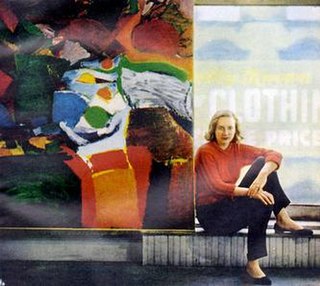
Grace Hartigan was an American Abstract Expressionist painter and a significant member of the vibrant New York School of the 1950s and 1960s. Her circle of friends, who frequently inspired one another in their artistic endeavors, included Jackson Pollock, Larry Rivers, Helen Frankenthaler, Willem and Elaine de Kooning and Frank O'Hara. Her paintings are held by numerous major institutions, including the Museum of Modern Art in New York City. As director of the Maryland Institute College of Art's Hoffberger School of Painting, she influenced numerous young artists.
Robert Amft was a painter, sculptor, photographer, designer born in Chicago.
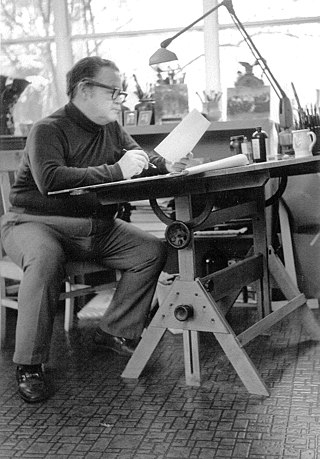
James F. Walker was an American graphic artist, twice named to the 100 Best New Talent List by Art in America. Walker was particularly noted for his mixed media surrealist images, which he called "magic realism". Walker was also an influential teacher. His work has been exhibited in America, as well as in Germany and in France.
Tristan Meinecke (1916–2004) was an American artist, architect and musician who spent most of his life and career in Chicago. He was married to television and radio actress Angel Casey. His widely varied body of work explored abstract expressionism, cubism and Surrealism, and included the invention of the split-level painting technique. In collaboration with architect Robert Bruce Tague, Meinecke built and rehabilitated many properties in and around Lincoln Park, Chicago.
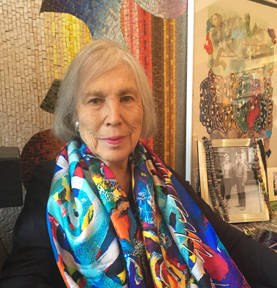
Amaranth Roslyn Ehrenhalt was an American painter, sculptor, and writer, who spent the majority of her career living and working in Paris, France before returning to New York City.

Walter Sanford, also known as Sanford,, was an American artist who worked in a range of styles and influences using traditional media such as paint, ink, crayon and pencil. His artworks include collages, cartoons, pencil drawings, linoleum-cuts, woodcuts, sculptures, paintings, and portraits. He was one of the first and only black social realism and abstract expressionist artists of the 20th century. He was heralded "Black Picasso" and "Detroit's Picasso" for his cubist figure paintings and in 1958 he won the Prix de Paris La Grande Saison de Paris at the Raymond Duncan Galleries. In Detroit, he opened the first black-owned art gallery and exhibited at the first Negro Art Exhibition and Negro History Week and was hailed as one of Michigan's foremost modern art painters in 1952.

Molly Zuckerman-Hartung is an American painter from Olympia, Washington. Since 2015 she has been faculty in Painting and Printmaking at the Yale School of Art.
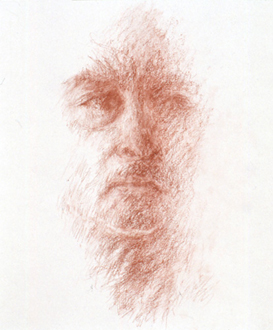
Arthur Lerner is an American artist, known for his atmospheric figurative paintings and drawings, landscapes, and still lifes. He is sometimes described as a realist, but most critics observe that his work is more subjective than descriptive or literal. Associated with Chicago's influential "Monster Roster" artists early in his career, he shared their enthusiasm for expressive figuration, fantasy and mythology, and their existential outlook, but diverged increasingly in his classical formal concerns and more detached temperament. Critics frequently note in Lerner's art a sense of light that evokes Impressionism, delicate color and modelling that "flirts with dematerialization," and the draftsmanship that serves as a foundation for all of his work. The Chicago Tribune's Alan Artner lamented Lerner's comparative lack of recognition in relation to the Chicago Imagists as the fate of "an aesthete in a town dominated by tenpenny fantasts." Lerner's work has been extensively covered in publications, featured in books such as Monster Roster: Existential Art in Postwar Chicago, and acquired by public and private collections, including those of the Smithsonian Institution, Art Institute of Chicago, Smart Museum of Art, and Mary and Leigh Block Museum of Art, among many.
Leopold Segedin is an American artist and educator based in Chicago. He is best known as an urban figurative painter, who portrays humanist scenes of life in mid-20th century Chicago. He has exhibited for over 70 years, including retrospectives at the Chicago Cultural Center, University Club of Chicago, University of Illinois, and Northeastern Illinois University, and major group shows at the Art Institute of Chicago, Milwaukee Institute of Art & Design, Illinois State Museum and Des Moines Art Center, among others. His art has received awards from the Art Institute of Chicago, Terry Art Institute, Corcoran Gallery of Art, and American Jewish Arts Club. Segedin was one of Art in America’s 1956 "New Talent in the U.S.A." artists and has been featured in The Washington Post, Chicago Tribune, The Philadelphia Inquirer, Chicago Daily News and Chicago Sun-Times, among many publications. Chicago Tribune critic Alan Artner characterized Segedin's work as a "distinguished example" of magic realism; in visual terms, critics have often noted his vivid color, dynamic illusionist space, and rendering of light and surfaces that betray the passage of time.
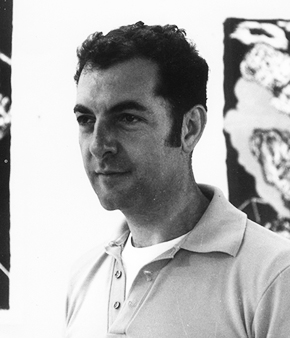
Seymour Rosofsky (1924–1981) was an American artist, who has been described as one of the key figures in twentieth-century Chicago art. He emerged in the late 1940s at the School of the Art Institute of Chicago, one of several G.I. Bill veterans, including Leon Golub, Cosmo Campoli and H. C. Westermann, who would join Don Baum, Dominick Di Meo, June Leaf, and Nancy Spero to form the influential movement later dubbed the "Monster Roster" by critic Franz Schulze, which was a precursor to the more well-known Chicago Imagists. Like others in the group, Rosofsky was drawn to the unsettling, macabre side of Surrealism, initially creating gestural, expressionist renderings of grotesque, existentially angst-ridden figures in isolated or uncomfortable situations, that gave way in the 1960s to more fantastical, observational paintings that examined power, politics and domestic relationships in an unflinching way.

Robert Morris Donley is an American artist who has been identified with the Chicago Imagist movement. Judith Wilson of the Village Voice called him the "Chicago imagist Tolstoy." The narrative aspects of his work center on broad social and political statements that are complex--often playful and satirical with respect to ways in which propaganda, power, and social diversity mix with and conflict with historical and religious personalities. In his career retrospective in 2000 at the Chicago Cultural Center, Dr. Paul Jaskot wrote that "his art investigates the changing political and social geographies of [the modern] city."
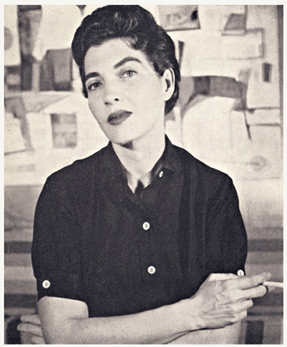
Ethel Fisher was an American painter whose career spanned more than seven decades in New York City, Miami and Los Angeles. Her work ranges across abstraction and representational genres including large-scale portraiture, architectural "portraits," landscape and still-life, and is unified by a sustained formal emphasis on color and space. After studying at the Art Students League in the 1940s, Fisher found success as an abstract artist in Florida in the late 1950s, and began exhibiting her work nationally and in Havana, Cuba. Her formative work of this period embraced the history of art, architecture and anthropology; she referred to it as "abstract impressionist" to distinguish her approach to form and color from that of Abstract Expressionism.
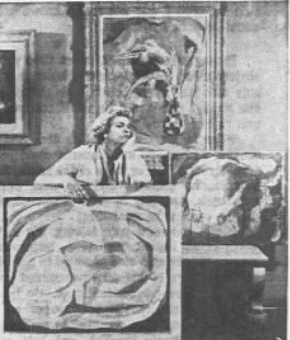
Scribner Ames (1908–1993) was an American artist known for her paintings and sculpture. Her paintings included portraits, still lifes, landscapes, and abstractions. Her portrait sitters were often children or well-known men and women in the performing arts. Born and raised in Chicago, she worked first in Manhattan and later returned to her birth city. She also made repeated trips to Europe and, once, to the West Indies. Although she admired the work of Cézanne, Braque, and Marsden Hartley, her painting was, as one critic said, "not derivative". Critics noted her effective handling of color and one said she was "particularly noted for her work in creating movement through space by the use of color perspective." In her carved wood sculpture, critics generally noted the influence of her teacher, José de Creeft.
Thomas Harry Kapsalis was a professor at the School of the Art Institute of Chicago and a leading American abstract painter and sculptor.













